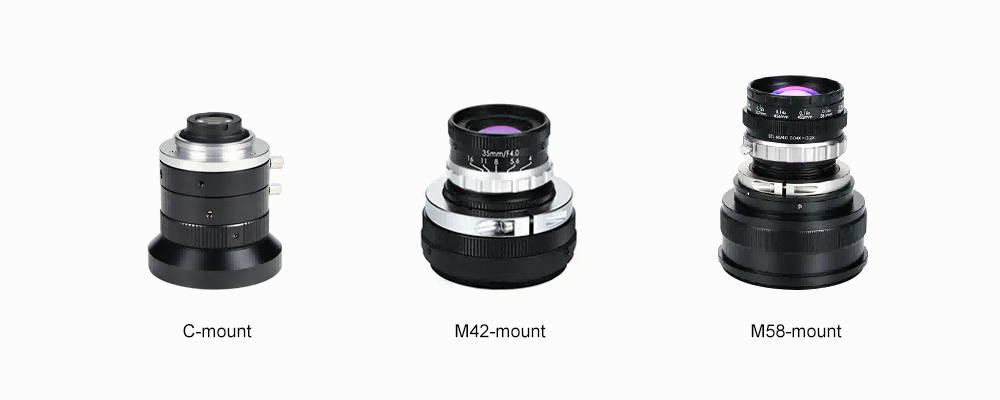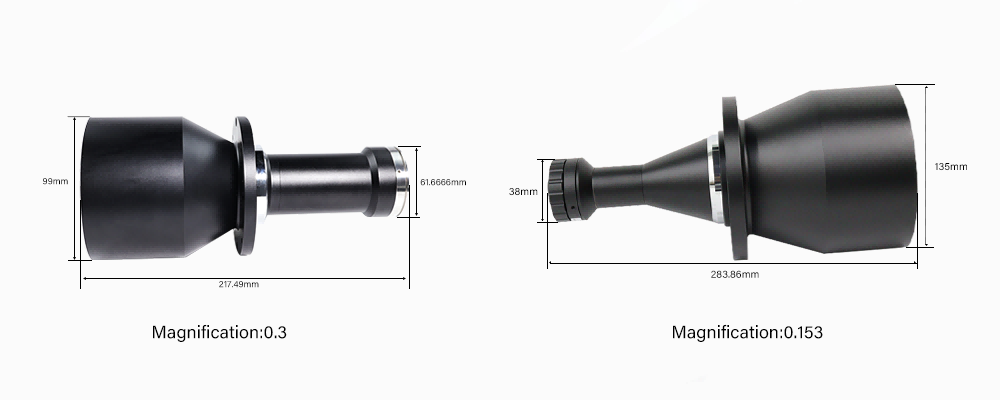A Step-by-Step Guide to Selecting Industrial Lenses
If you already have an industrial camera, then how do you choose a suitable lens for it? There are two main types of industrial lenses: FA lenses and Telecentric lenses.
FA Lens
FA lenses, focus on four key parameters: Target size, Focal Length, Aperture, and Mount.
1. Target size (Sensor Size Compatibility)
The maximum size of the image projected onto the camera sensor (e.g., 1.1”, 1”, 2/3”, 1/1.8”). The lens target size must be equal to or larger than the camera’s sensor size. A smaller lens target size causes black edges or vignetting (dark corners) in the image.
example: A 2/3'' camera can use a 2/3'' or 1'' lens, but not a 1/1.8'' lens
2. Focal length
The focal length is mainly used to adjust the installation height and field of view, which refers to the distance from the focus to the imaging surface. Common options: 6mm, 8mm, 12mm, 16mm, 25mm, etc.
Key tips:
Shorter focal length = wider FOV but stronger distortion (e.g., 6mm/8mm lenses may show visible barrel distortion).
Longer focal length = narrower FOV but less distortion.
Check the lens’s minimum working distance (closest focus range). If the lens is too close to the object, it won’t focus.
3. Aperture
Controls the amount of light entering the lens, labeled as F2.8, F4, F8, etc. The smaller the F, the larger the aperture.
Usually, for projects that do not require depth of field, the aperture is adjusted to the maximum to ensure sufficient light intake, especially in some high-speed application scenes. But the advantage of a small aperture is that it can make the depth of field larger. Adjust it according to the actual project.
4. Mount
The threaded interface connecting the lens to the camera (e.g., C-mount, M42, M58). Smaller target size (≤1.2”) typically use C-mount. Larger sensors (e.g., 4K/8K line-scan cameras) require bigger mounts like M42/M58/M72.
The larger the lens target size, the larger the corresponding thread opening needs to be, otherwise it will block the fov.

Telecentric lens
Telecentric lenses, with their unique optical properties, high resolution, ultra-wide depth of field, ultra-low distortion and unique parallel optical path design, have brought a qualitative leap in machine vision precision detection.
When selecting a lens, it is often necessary to calculate the fov to meet the detection requirements. How to calculate the fov of a telecentric lens?
There are three common parameters of telecentric lenses: target surface, working distance and magnification:
1. Target size
Same rule as FA lenses: Must cover the camera’s sensor size.
2. Working Distance
Definition: The distance from the lens’s bottom surface to the object.
Critical: The object must be placed within this range for sharp focus.
3. Magnification
Magnification is related to fov
FOV = Sensor Size ÷ Magnification.
Example: A 12mm sensor with 0.5x magnification = 24mm FOV.
The smaller the magnification of the lens, the larger the lens barrel will be and the higher the cost will be, because the lens needs to completely cover the field of view.

Quick Summary
FA Lenses: Prioritize image circle size, focal length (avoid extreme values), aperture (balance light and depth of field), and mount compatibility.
Telecentric Lenses: Choose based on sensor size, working distance, and magnification for precision tasks.


